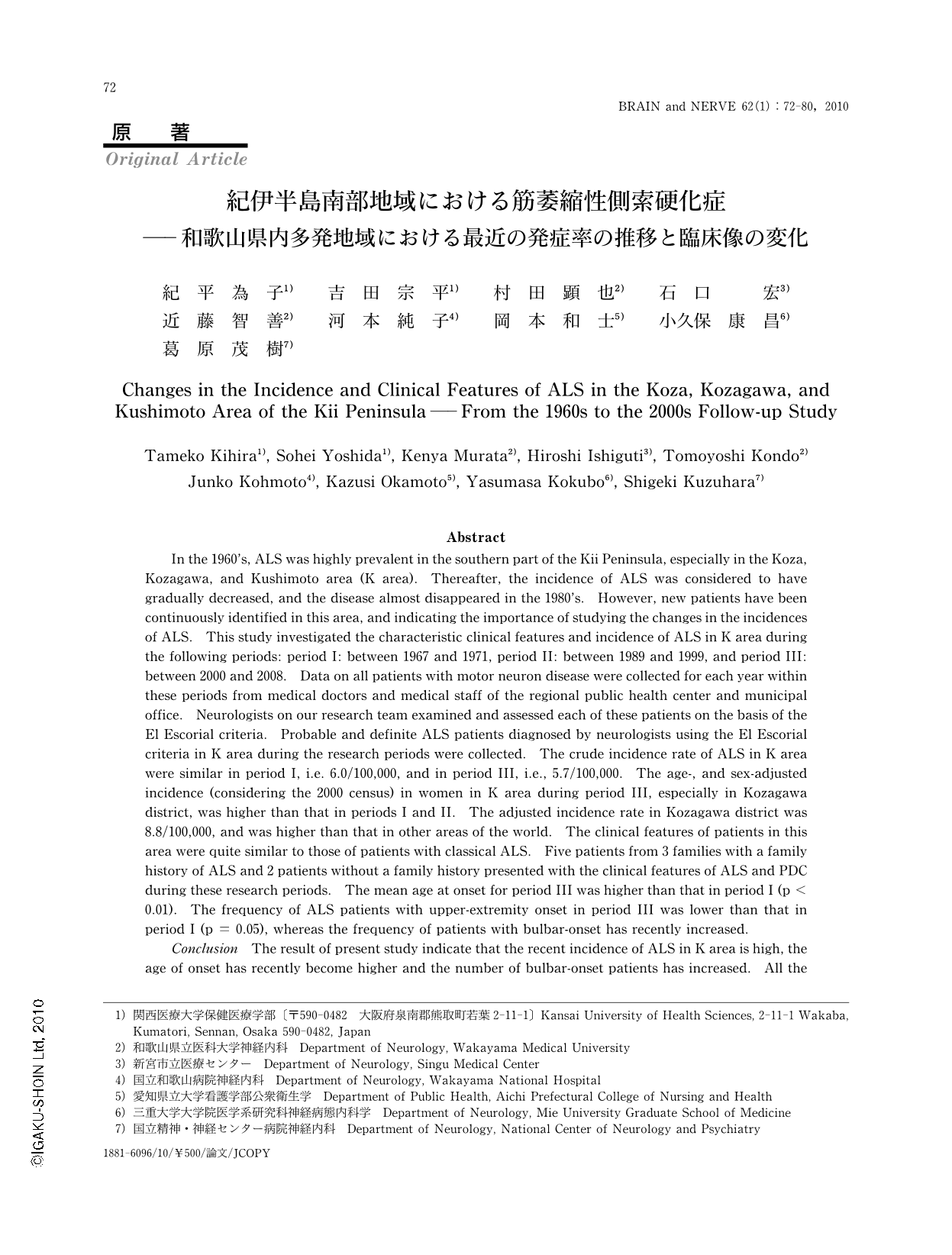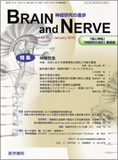Japanese
English
- 有料閲覧
- Abstract 文献概要
- 1ページ目 Look Inside
- 参考文献 Reference
はじめに
1911年,三浦謹之助により紀伊半島における筋萎縮性側索硬化症(amyotrophic lateral sclerosis,ALS)の多発が最初に報告された。1960年代には,紀伊半島古座川地区(Kzg地区)1),穂原地区(H地区)2),グアム島南部,西ニューギニアにおいてALSの集積発症が明らかにされ3),紀伊半島南部地域では欧米に比してALS有病率が100~150倍高いと報告された4-6)。その後これら多発地域でのALS発症率は低下を示し7),1980年代には激減,さらにグアム島ではALS多発は消失したと報告された8)。これより,多発地でのALS発症に環境要因の関与が推察され,地域の土壌,水質の調査がなされたが,病因はいまだ解明されていない9)。われわれは紀伊半島のALS症例について継続的に調査してきたが,紀伊半島南部地域で2000年以降も新たな発症が認められている10,11)。1980年代に激減したと考えられていたALSが,最近でも新規に発症していることから,紀伊半島においてALS多発が現在も継続しているかを検討することは,発症関連要因の解明,さらに病因解明に重要と考えられる。
Abstract
In the 1960's, ALS was highly prevalent in the southern part of the Kii Peninsula, especially in the Koza, Kozagawa, and Kushimoto area (K area). Thereafter, the incidence of ALS was considered to have gradually decreased, and the disease almost disappeared in the 1980's. However, new patients have been continuously identified in this area, and indicating the importance of studying the changes in the incidences of ALS. This study investigated the characteristic clinical features and incidence of ALS in K area during the following periods: period I: between 1967 and 1971, period Ⅱ: between 1989 and 1999, and period III: between 2000 and 2008. Data on all patients with motor neuron disease were collected for each year within these periods from medical doctors and medical staff of the regional public health center and municipal office. Neurologists on our research team examined and assessed each of these patients on the basis of the El Escorial criteria. Probable and definite ALS patients diagnosed by neurologists using the El Escorial criteria in K area during the research periods were collected. The crude incidence rate of ALS in K area were similar in period I, i.e. 6.0/100,000, and in period III, i.e., 5.7/100,000. The age-, and sex-adjusted incidence (considering the 2000 census) in women in K area during period III, especially in Kozagawa district, was higher than that in periods I and Ⅱ. The adjusted incidence rate in Kozagawa district was 8.8/100,000, and was higher than that in other areas of the world. The clinical features of patients in this area were quite similar to those of patients with classical ALS. Five patients from 3 families with a family history of ALS and 2 patients without a family history presented with the clinical features of ALS and PDC during these research periods. The mean age at onset for period III was higher than that in period I (p < 0.01). The frequency of ALS patients with upper-extremity onset in period III was lower than that in period I (p = 0.05), whereas the frequency of patients with bulbar-onset has recently increased.
Conclusion The result of present study indicate that the recent incidence of ALS in K area is high, the age of onset has recently become higher and the number of bulbar-onset patients has increased. All the abovementioned findings could be attributed to an increase in the senility rate in the population. Between 2000 and 2008, the age-adjusted incidence in ALS for women in K area, especially in the Kozagawa district, was high, indicating an increase in that the incidence of ALS among women in this area after 2000. The factors responsible for the high incidence of ALS in this area remain to be clarified.
(Received: August 3,2009,Accepted: September 9,2009)

Copyright © 2010, Igaku-Shoin Ltd. All rights reserved.


